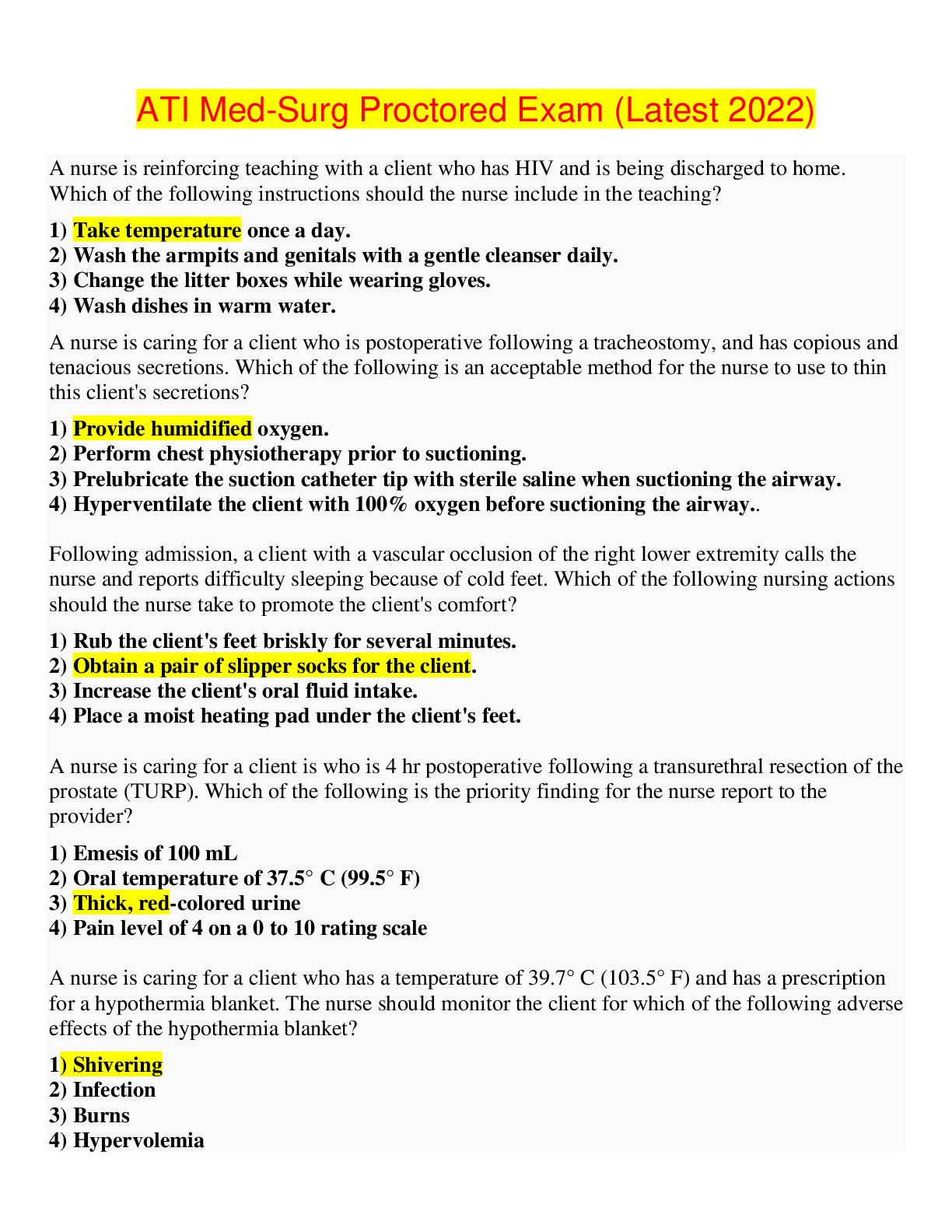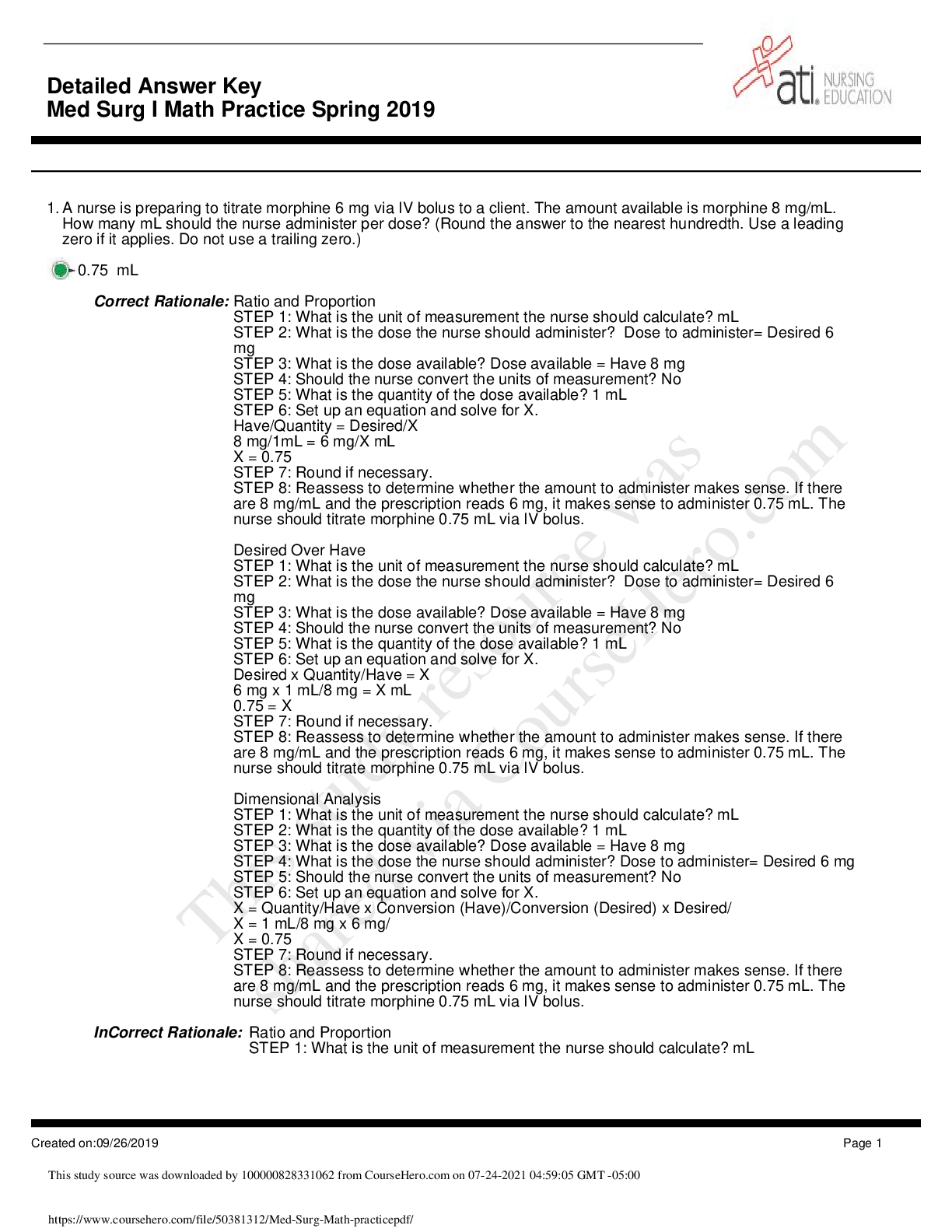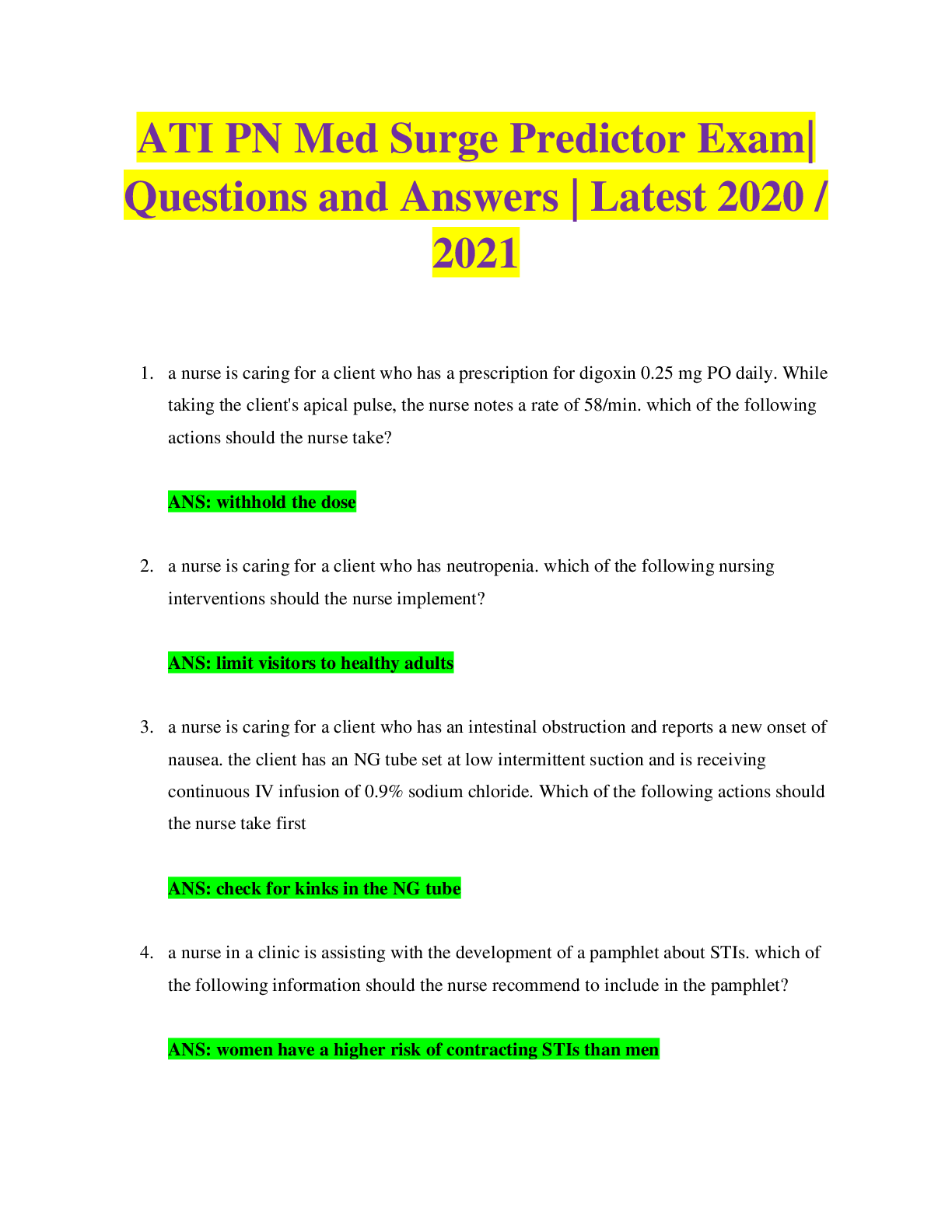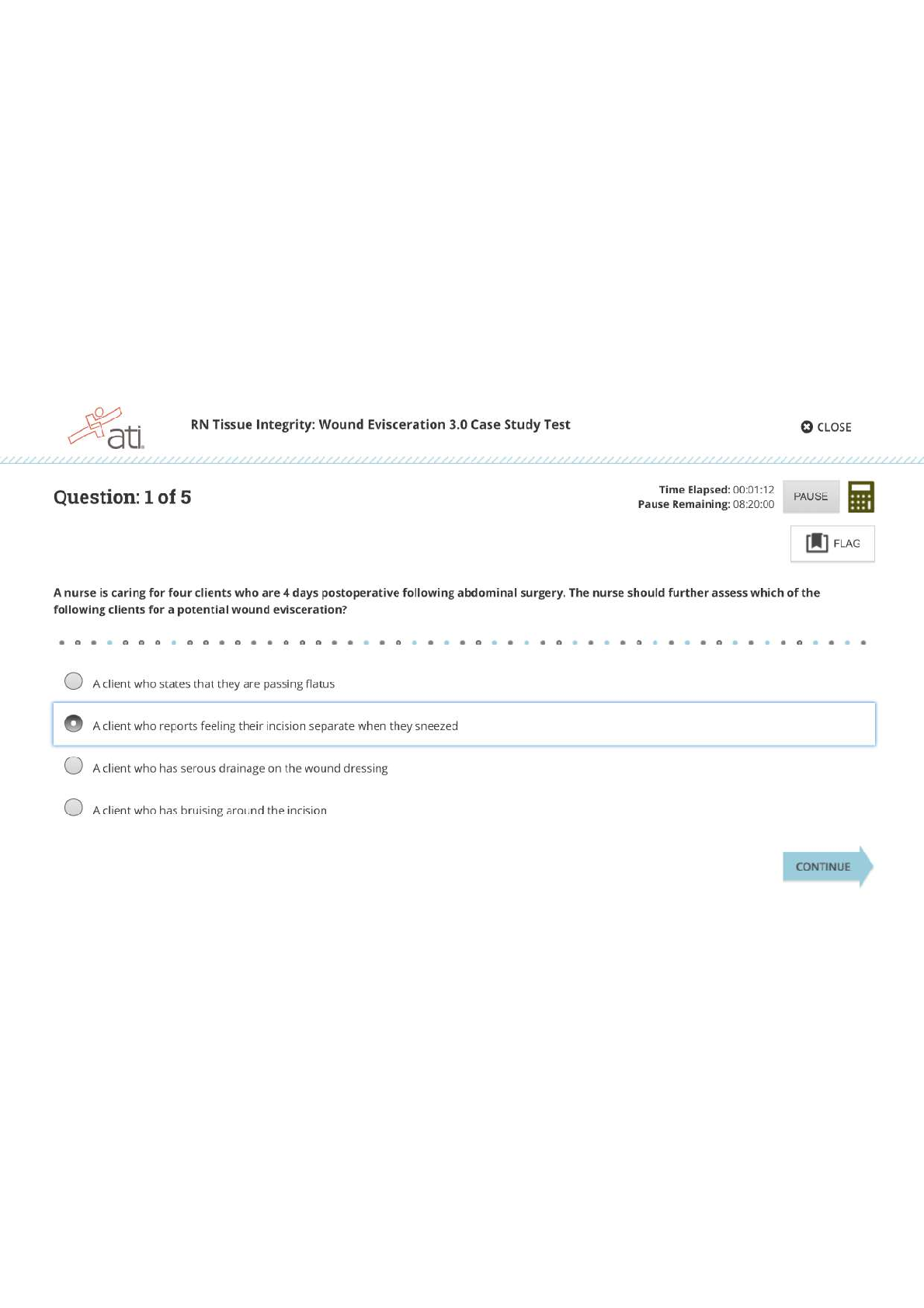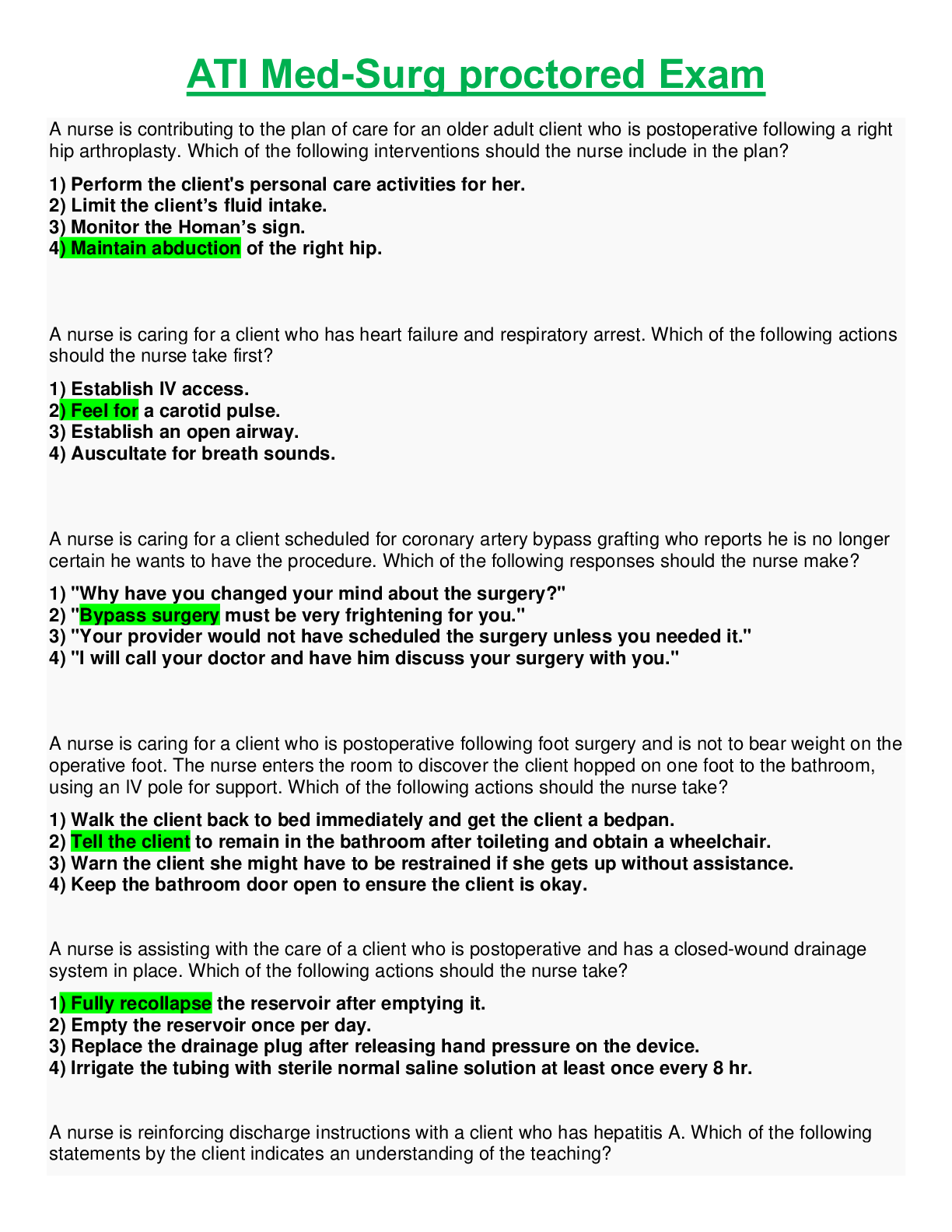*NURSING > ATI MEDICAL SURGICAL > ATI Med-Surg Test Banks Questions & answers( complete guide to score an A)New 2021 (All)
ATI Med-Surg Test Banks Questions & answers( complete guide to score an A)New 2021
Document Content and Description Below
A nurse is reinforcing teaching with a client who has HIV and is being discharged to home. Which of the following instructions should the nurse include in the teaching? 1) Take temperature once a d... ay. Answer Rationale: The nurse should reinforce to the client to take his temperature once a daily to identify if a temperature is present due to the client’s altered immune system. INCORRECT 2) Wash the armpits and genitals with a gentle cleanser daily. Answer Rationale: The nurse should instruct the client to use an antimicrobial cleanser to wash his armpits and genitals twice daily. INCORRECT 3) Change the litter boxes while wearing gloves. Answer Rationale: The client should avoid changing litter boxes. Litter boxes carry toxoplasmosis which can be life threatening to a client who has HIV. INCORRECT 4) Wash dishes in warm water. Answer Rationale: The nurse should instruct the client to wash dishes in hot soapy water to destroy the bacteria. 2. A nurse is caring for a client who is postoperative following a tracheostomy, and has copious and tenacious secretions. Which of the following is an acceptable method for the nurse to use to thin this client's secretions? 1) Provide humidified oxygen. Answer Rationale: Increasing fluid intake as tolerated and providing adequate humidification can help thin secretions safely. INCORRECT 2) Perform chest physiotherapy prior to suctioning. Answer Rationale: Performing chest physiotherapy mobilizes secretions but does not thin them. INCORRECT 3) Prelubricate the suction catheter tip with sterile saline when suctioning the airway. Answer Rationale: Prelubricating the suction catheter tip with sterile saline helps to ease the insertion of the catheter, producing less trauma. However, it has no effect on the tenacity of the client's secretions. INCORRECT 4) Hyperventilate the client with 100% oxygen before suctioning the airway. Answer Rationale: Hyperventilating the client prior to suctioning prevents hypoxia. However, it has no effect on the tenacity of the client's secretions. 3. Following admission, a client with a vascular occlusion of the right lower extremity calls the nurse and reports difficulty sleeping because of cold feet. Which of the following nursing actions should the nurse take to promote the client's comfort? INCORRECT 1) Rub the client's feet briskly for several minutes. Answer Rationale: Massaging the legs or feet could mobilize a clot. Impaired arterial or venous circulation of the lower extremities is a contraindication for leg massage. 2) Obtain a pair of slipper socks for the client. Answer Rationale: Slipper socks with nonskid soles will help provide warmth and increase the client's level of comfort. INCORRECT 3) Increase the client's oral fluid intake. Answer Rationale: Increasing the client's fluid intake will not increase circulation to an area an occlusion impairs. INCORRECT 4) Place a moist heating pad under the client's feet. Answer Rationale: Impaired arterial or venous circulation to a lower extremity is a contraindication for applying a heating pad. 4. A nurse is caring for a client is who is 4 hr postoperative following a transurethral resection of the prostate (TURP). Which of the following is the priority finding for the nurse report to the provider? INCORRECT 1) Emesis of 100 mL Answer Rationale: The nurse should recognize postoperative nausea is a complication related to the administration of anesthesia and should treat the nausea with anti-emetics and provide supportive measures; however, it is not the priority finding. INCORRECT 2) Oral temperature of 37.5° C (99.5° F) Answer Rationale: The nurse should monitor a client who develops a fever and encourage deep breathing, coughing, and fluid intake (if permitted); however, it is not the priority finding to report. The increase in temperature is likely due to decreased respiratory effort related to the use of anesthesia and should clear with pulmonary hygiene. 3) Thick, red-colored urine Answer Rationale: The nurse should recognize viscous drainage that is red in color may indicate hemorrhage and should be reported to the provider immediately. INCORRECT 4) Pain level of 4 on a 0 to 10 rating scale Answer Rationale: The nurse should assess for and treat postoperative pain which is an expected finding in the postoperative client; however it is not the priority finding to report. Specific pain, such as bladder spasms, may indicate complications however and should be reported to the provider. 5. A nurse is caring for a client who has a temperature of 39.7° C (103.5° F) and has a prescription for a hypothermia blanket. The nurse should monitor the client for which of the following adverse effects of the hypothermia blanket? 1) Shivering Answer Rationale: The hypothermia blanket can cause shivering if the client is cooled too quickly. Shivering can cause the client’s temperature to increase. INCORRECT 2) Infection Answer Rationale: Infection is not a complication of the hypothermia blanket therapy. A manifestation of infection is hyperthermia. INCORRECT 3) Burns Answer Rationale: Burns are associated with the improper use of heating pads, not hypothermia blankets. INCORRECT 4) Hypervolemia Answer Rationale: Hypervolemia is not a complication of the hypothermia blanket therapy. Dehydration is a risk associated with hyperthermia due to fluid loss. 6. A nurse is reinforcing teaching about exercise with a client who has type 1 diabetes mellitus. Which of the following statements by the client indicates an understanding of the teaching? INCORRECT 1) "I will carry a complex carbohydrate snack with me when I exercise." Answer Rationale: The nurse should reinforce that the client should carry a simple carbohydrate such as hard candy or glucose tablets for use during exercise if the client becomes hypoglycemic. INCORRECT 2) "I should exercise first thing in the morning before eating breakfast." Answer Rationale: The nurse should reinforce that exercise should follow a meal. Exercising first thing in the morning on an empty stomach places the client at risk for hypoglycemia. INCORRECT 3) "I should avoid injecting insulin into my thigh if I am going to go running." Answer Rationale: The nurse should reinforce that the client should avoid injecting insulin into an area that will soon be exercised to avoid increasing the absorption rate of the insulin. 4) "I will not exercise if my urine is positive for ketones." Answer Rationale: The nurse should reinforce that exercise should be avoided if ketones are present in the urine as this indicates an elevated blood glucose level or ketoacidosis. 7. A nurse notes a small section of bowel protruding from the abdominal incision of a client who is postoperative. After calling for assistance, which of the following actions should the nurse take first? 1) Cover the client's wound with a moist, sterile dressing. Answer Rationale: According to evidence-based practice, the nurse's first action should be to cover the wound with a moist, sterile dressing to prevent entry of bacteria into the wound and to keep the tissue moist. INCORRECT 2) Have the client lie supine with knees flexed. Answer Rationale: The nurse should have the client lie supine with knees flexed to promote adequate circulation to the vital organs. However, evidence-based practice indicates that this is not the first action the nurse should take. INCORRECT 3) Check the client's vital signs. Answer Rationale: The nurse should check the client’s vital signs because the client is at risk for shock following wound evisceration. However, evidence-based practice indicates that this is not the first action the nurse should take. INCORRECT 4) Inform the client about the need to return to surgery. Answer Rationale: The nurse should inform the client about the need to return to emergency surgery to preserve the bowel and prevent complications. However, evidence-based practice indicates that this is not the first action the nurse should take. 8. A nurse is collecting data from a client who has alcohol use disorder and is experiencing metabolic acidosis. Which of the following manifestations should the nurse expect? INCORRECT 1) Cool, clammy skin Answer Rationale: The nurse should expect to find warm, flushed skin in a client who is experiencing metabolic acidosis. 2) Hyperventilation Answer Rationale: The nurse should expect to find hyperventilation in a client who is experiencing metabolic acidosis. The system attempts to compensate or return the pH to normal by increasing the rate and depth of respirations. INCORRECT 3) Increased blood pressure Answer Rationale: The nurse should expect to find hypotension in a client who is experiencing metabolic acidosis. INCORRECT 4) Bradycardia Answer Rationale: The nurse should expect to find tachycardia in a client who is experiencing metabolic acidosis. 9. A nurse is reinforcing discharge teaching with a client following a cataract extraction. Which of the following should the nurse include in the teaching? 1) Avoid bending at the waist. Answer Rationale: The nurse should reinforce that the client should avoid bending at the waist as this increases intraocular pressure; the client should be instructed to flex the knees and crouch instead. INCORRECT 2) Remove the eye shield at bedtime. Answer Rationale: The client should be instructed to use an eye shield when retiring for the night to protect the eye from accidental injury, such as rubbing that may occur when the client is asleep. INCORRECT 3) Limit the use of laxatives if constipated. Answer Rationale: The client should be encouraged to use laxatives in the event of constipation to avoid straining while attempting to have a bowel movement. Straining increases intraocular pressure and can cause damage to the surgical site. INCORRECT 4) Seeing flashes of light is an expected finding following extraction. Answer Rationale: The nurse should instruct the client that flashes of light indicates a complication of cataract extraction, and should be reported to the provider. 10.A nurse is caring for a client who has heart failure and has been taking digoxin 0.25 mg daily. The client refuses breakfast and reports nausea. Which of the following actions should the nurse take first? INCORRECT 1) Suggest that the client rests before eating the meal. Answer Rationale: The nurse should encourage frequent rest periods for the client who has heart failure, as dyspnea and fluid overload increases the workload to consume adequate nutrition; however, another action is the priority. INCORRECT 2) Request a dietary consult. Answer Rationale: The nurse should consider obtaining a dietary consult for the client who has heart failure to provide nutritional evaluation and counseling; however, another action is the priority. 3) Check the client's vital signs. Answer Rationale: When using the airway, breathing, circulation approach to client care, the nurse should place the priority on obtaining vital signs. Nausea is a manifestation of digoxin toxicity, along with other manifestations such as muscle weakness, confusion, abdominal cramping, and changes in vision. INCORRECT 4) Request an order for an antiemetic. Answer Rationale: The nurse should request antiemetics for the client who is experiencing nausea in order to maintain client comfort and nutritional intake; however, another action is the priority. 11.A nurse is caring for a client who is 3 days postoperative following a cholecystectomy. The nurse suspects the client's wound is infected because the drainage from the dressing is yellow and thick. Which of the following findings should the nurse report as the type of drainage found? INCORRECT 1) Sanguineous Answer Rationale: Sanguineous indicates fresh bleeding. INCORRECT 2) Serous Answer Rationale: Serous describes clear, watery plasma. INCORRECT 3) Serosanguineous Answer Rationale: Serosanguineous describes watery drainage that has some blood in it. 4) Purulent Answer Rationale: Purulent describes drainage that is thick yellow, green, or brown in color. 12.A nurse is reinforcing discharge teaching to a client following arthroscopic surgery. To prevent postoperative complications which of the following actions should be reinforced during the teaching? 1) Administer an opioid analgesic to the client 30 min prior to initiating CPM exercises. Answer Rationale: The nurse should administer analgesics prior to initiating any exercise program for the client who has had joint arthroplasty. It is important that analgesics are administered in time for the medication to work before the start of the exercise program to ensure discomfort is minimized. INCORRECT 2) Place the client’s affected leg into the CPM machine with the machine in the flexed position. Answer Rationale: The nurse should place the client’s leg in the CPM machine while the machine is in the extended position to allow for proper fit and comfort. INCORRECT 3) Place the client into a high Fowler’s position when initiating the CPM exercises. Answer Rationale: The nurse should limit the elevation of the client’s head of the bed to no more than 20 degrees while the client is using the CPM machine to avoid extreme flexion of the hip and patient discomfort. INCORRECT 4) Align the joints of the CPM machine with the knee gatch in the client’s bed. Answer Rationale: The nurse should align the joints of the CPM machine with the client’s knee joint to ensure safe operation of the unit and prevent injury to the client. 13.A nurse is collecting data from a client who has emphysema. Which of the following findings should the nurse expect? (Select all that apply.) 1) Dyspnea 2) Barrel chest 3) Clubbing of the fingers 4) Shallow respirations [Show More]
Last updated: 1 year ago
Preview 1 out of 74 pages
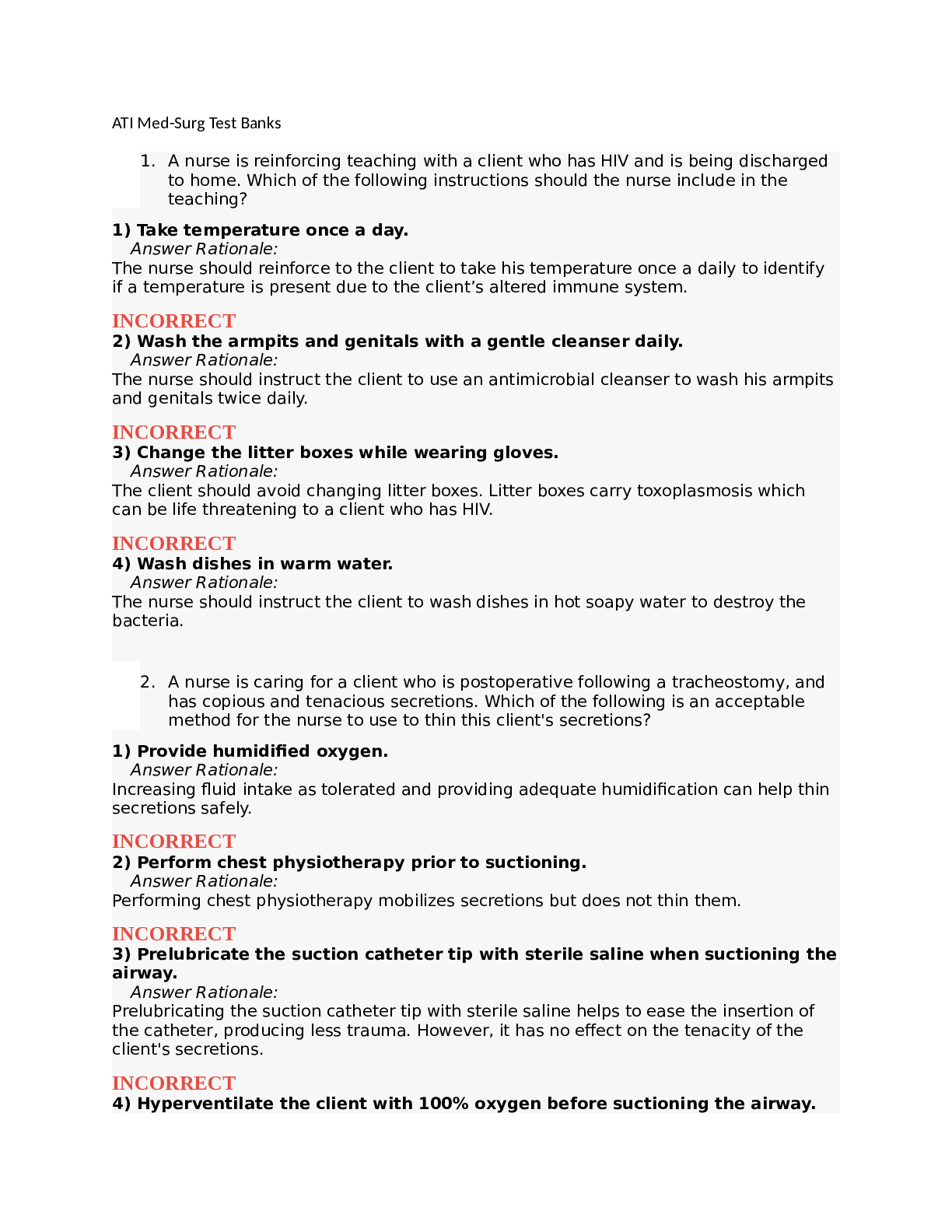
Reviews( 0 )
Document information
Connected school, study & course
About the document
Uploaded On
Mar 14, 2021
Number of pages
74
Written in
Additional information
This document has been written for:
Uploaded
Mar 14, 2021
Downloads
0
Views
102

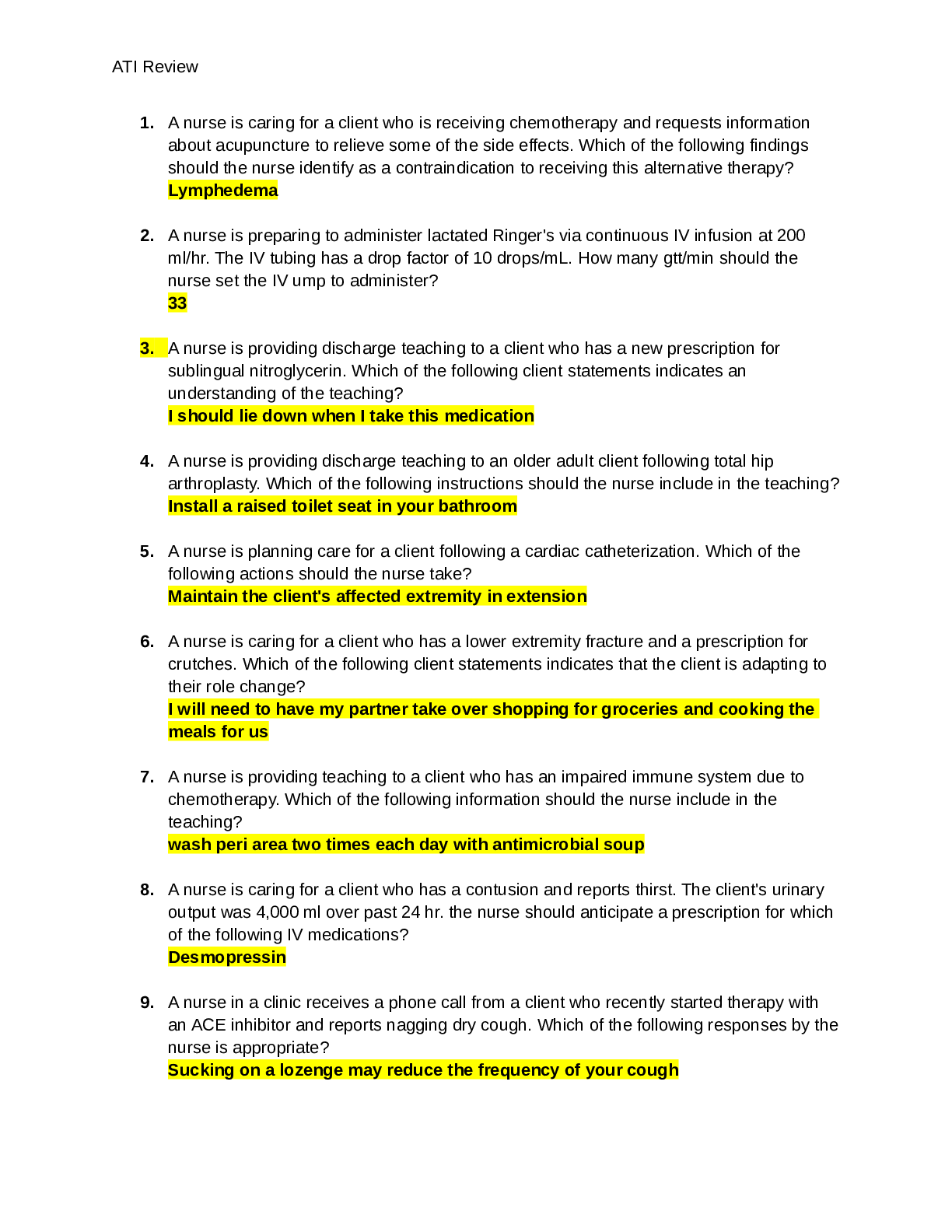
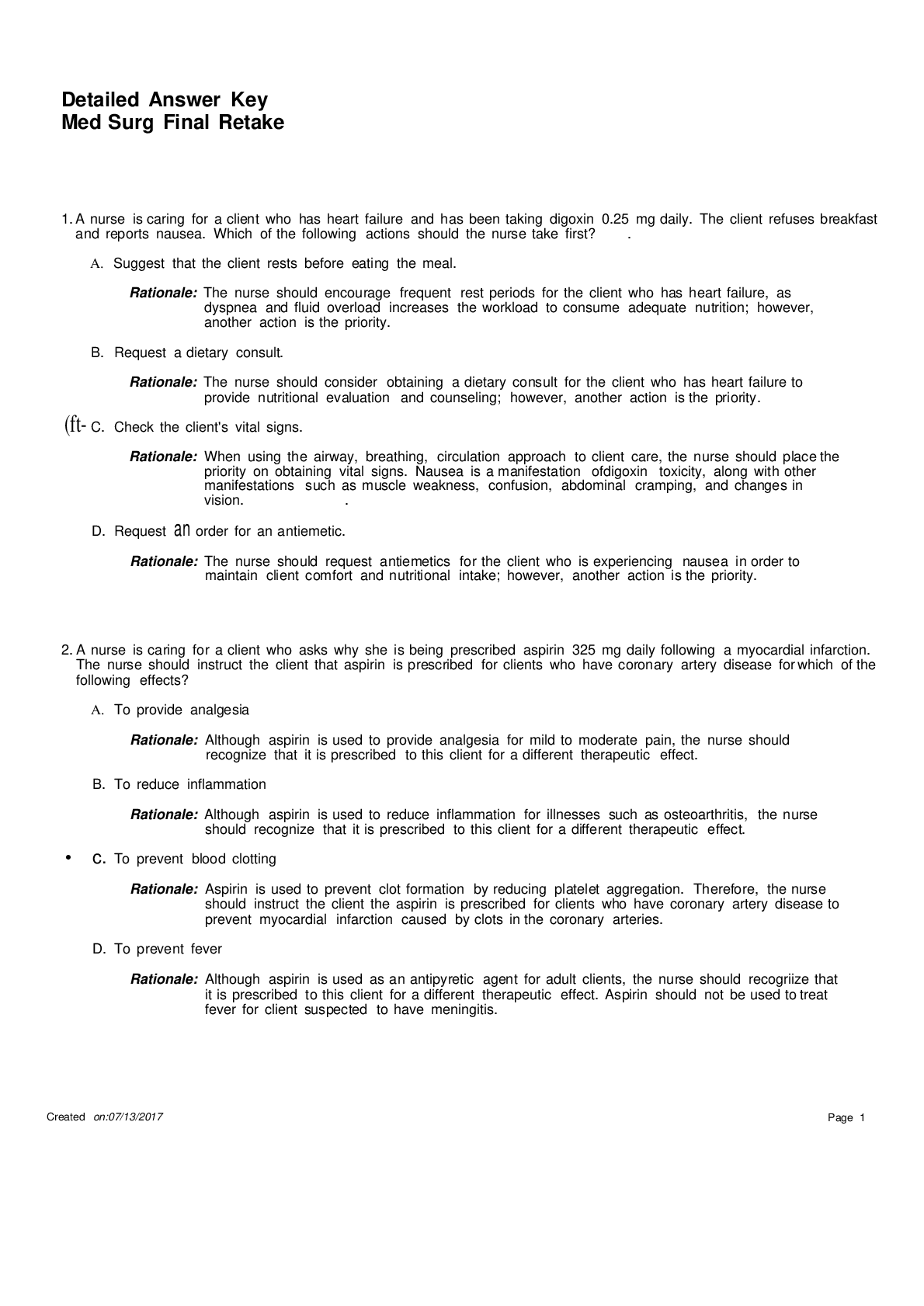
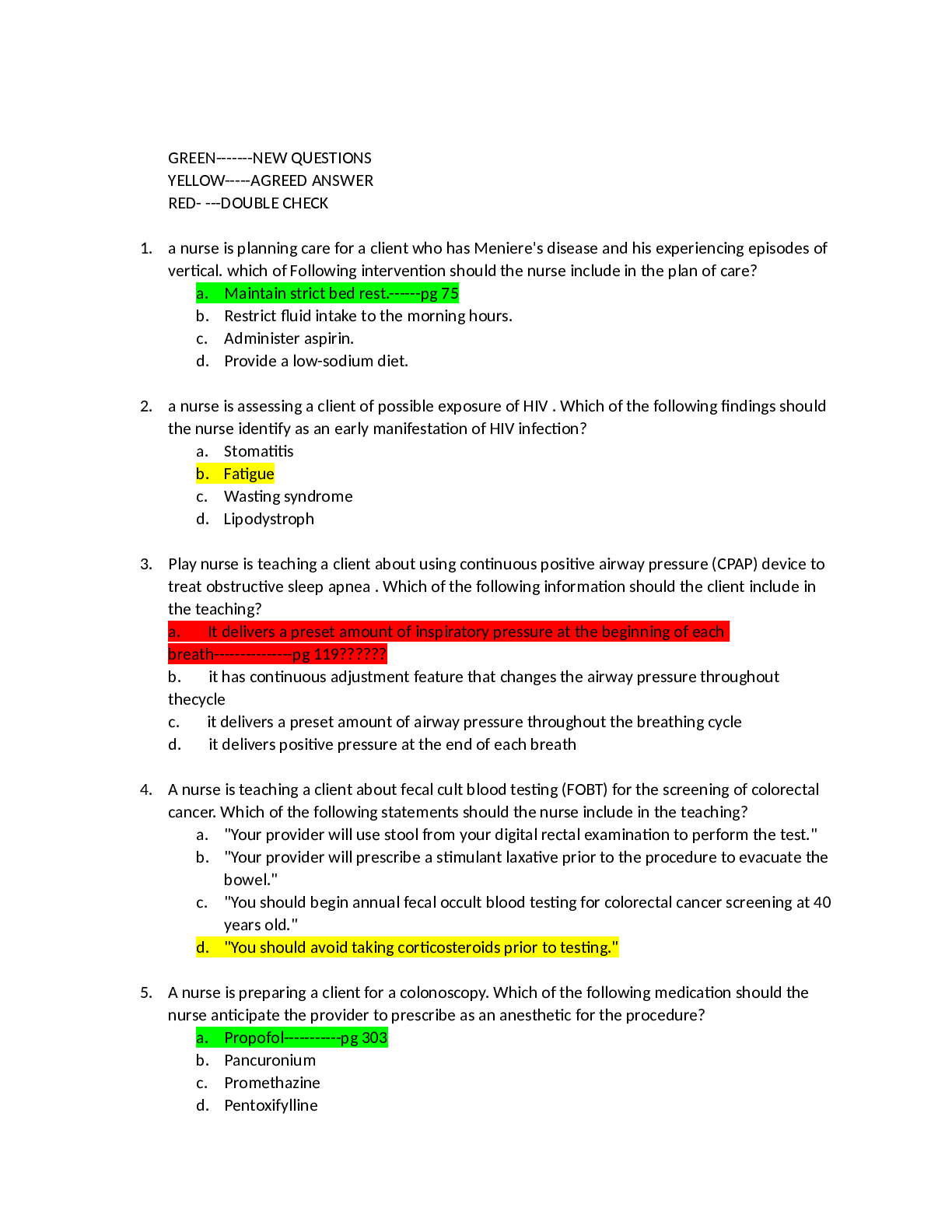
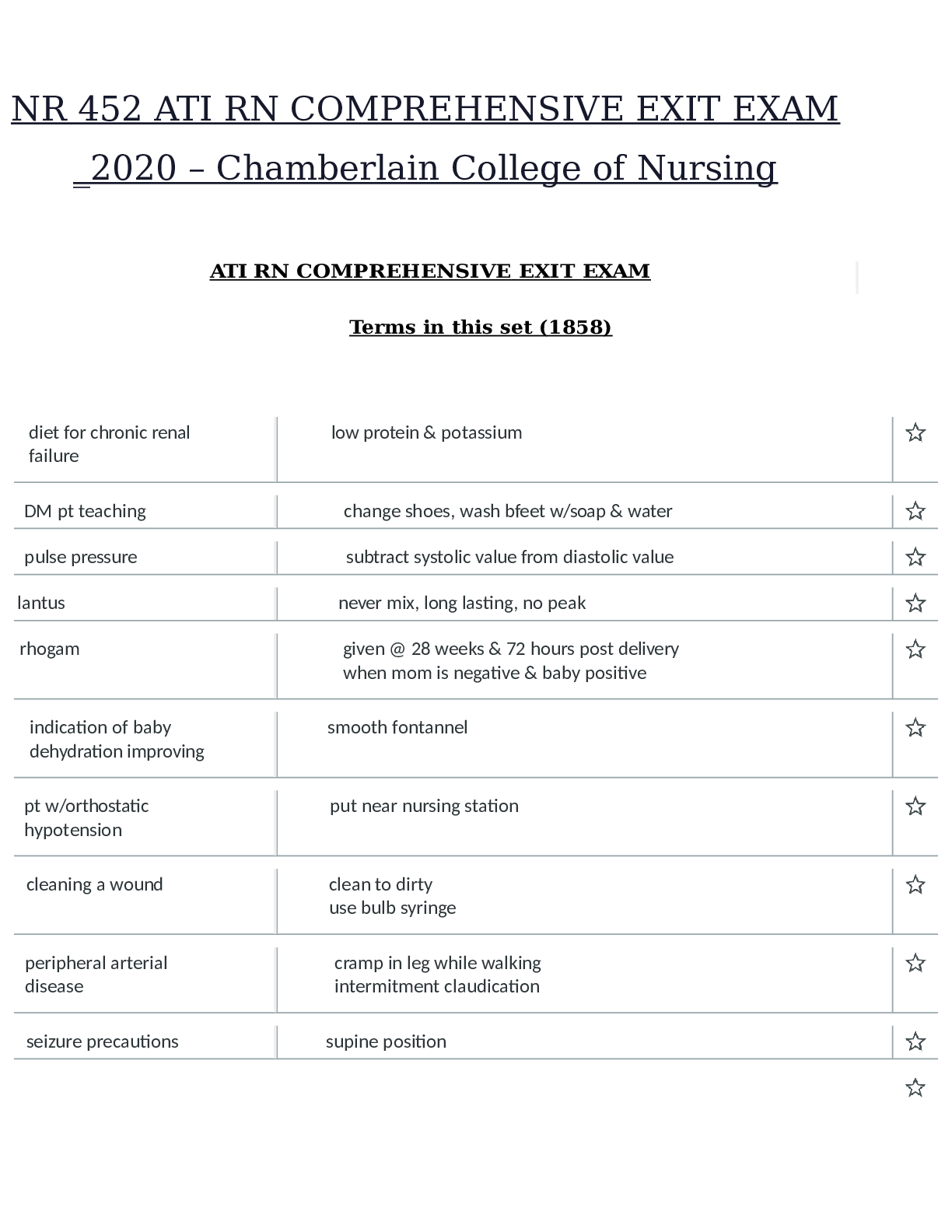
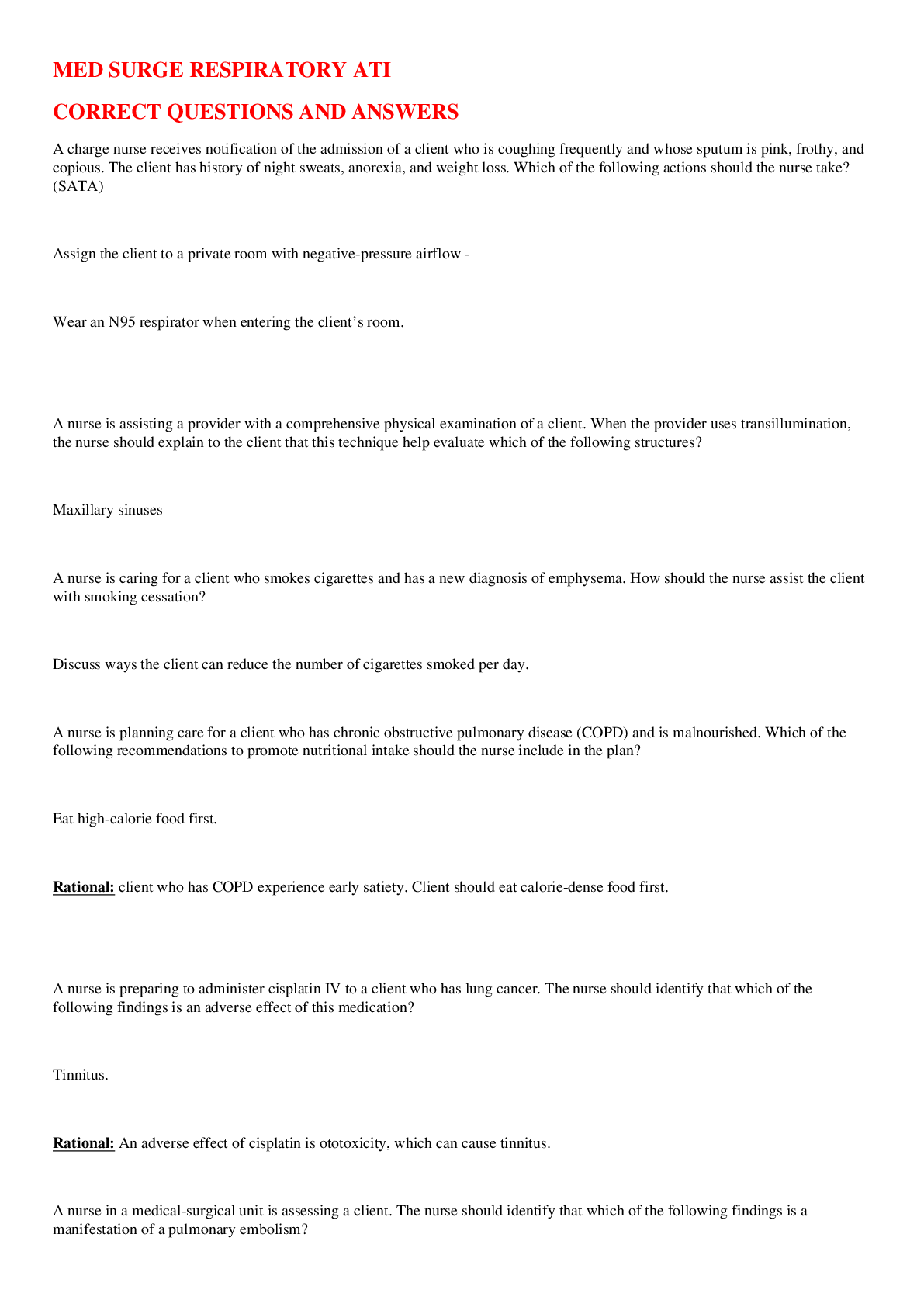
.png)
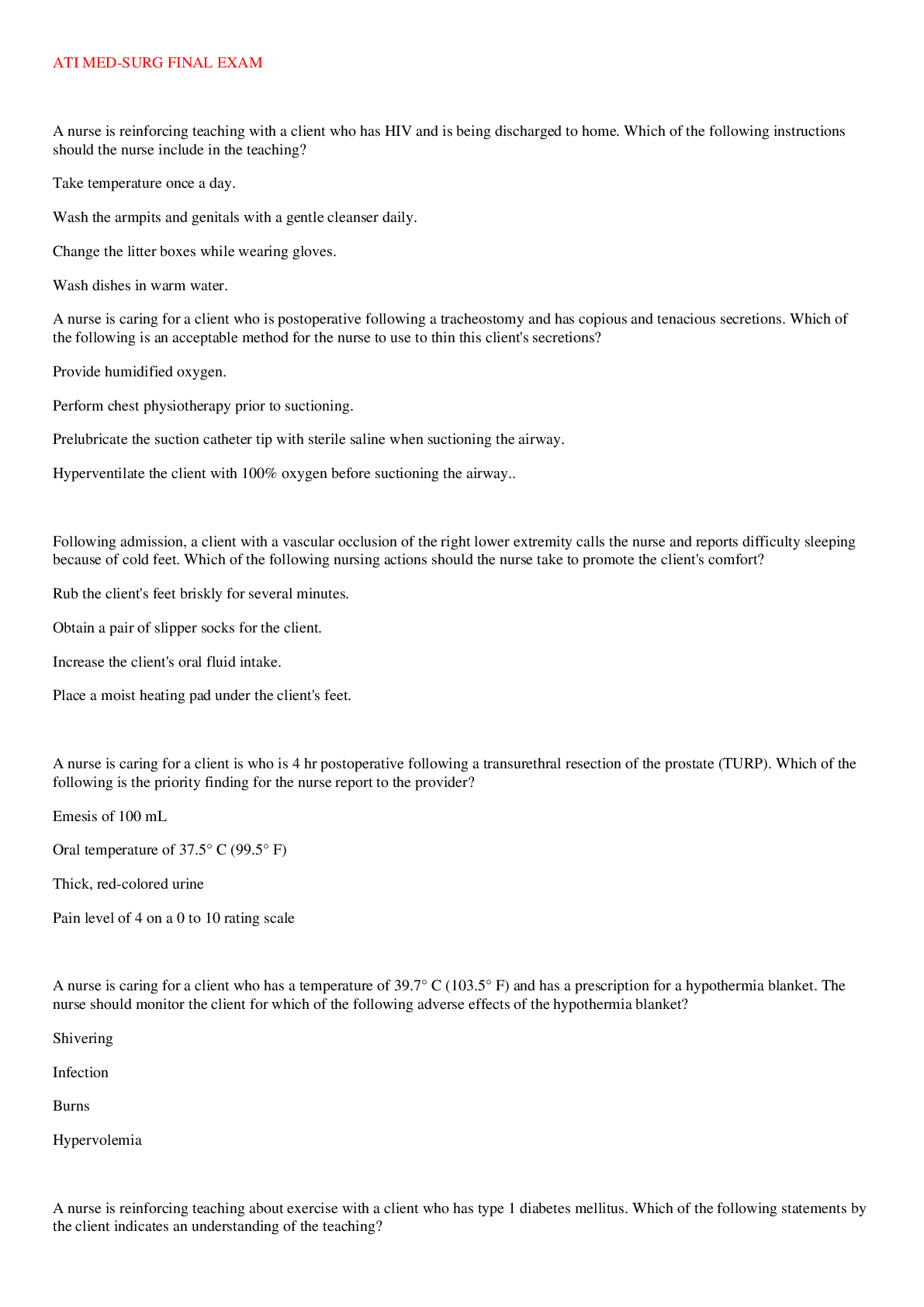
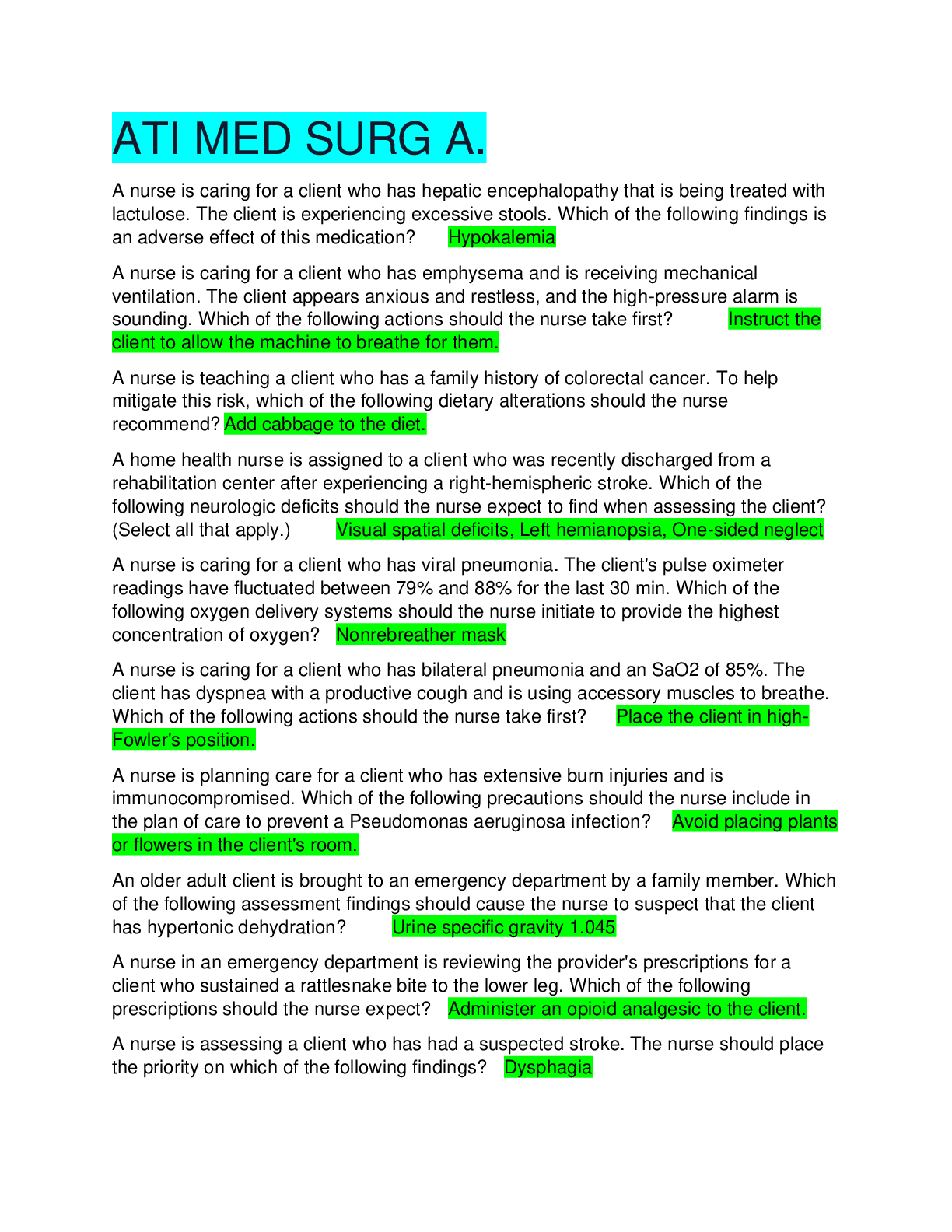
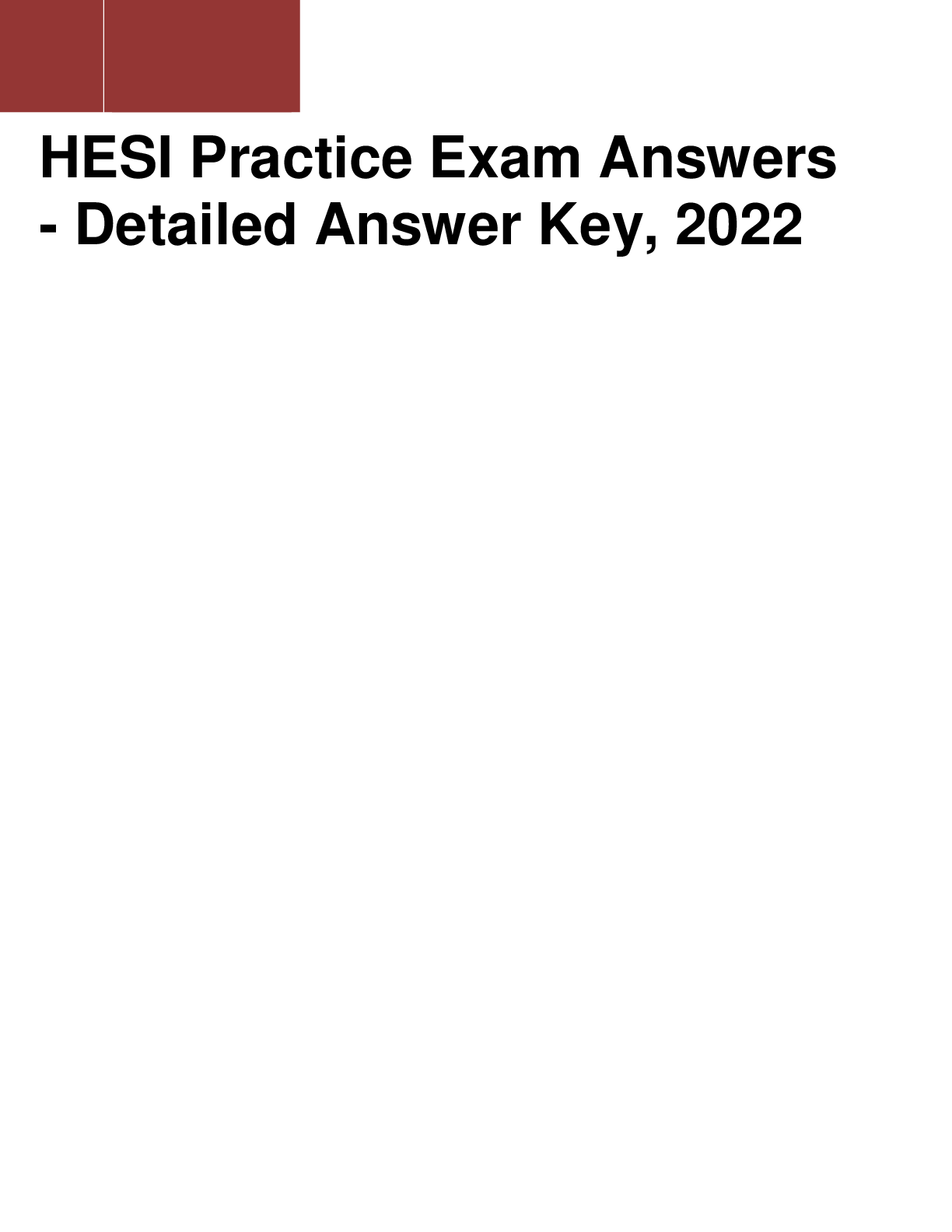


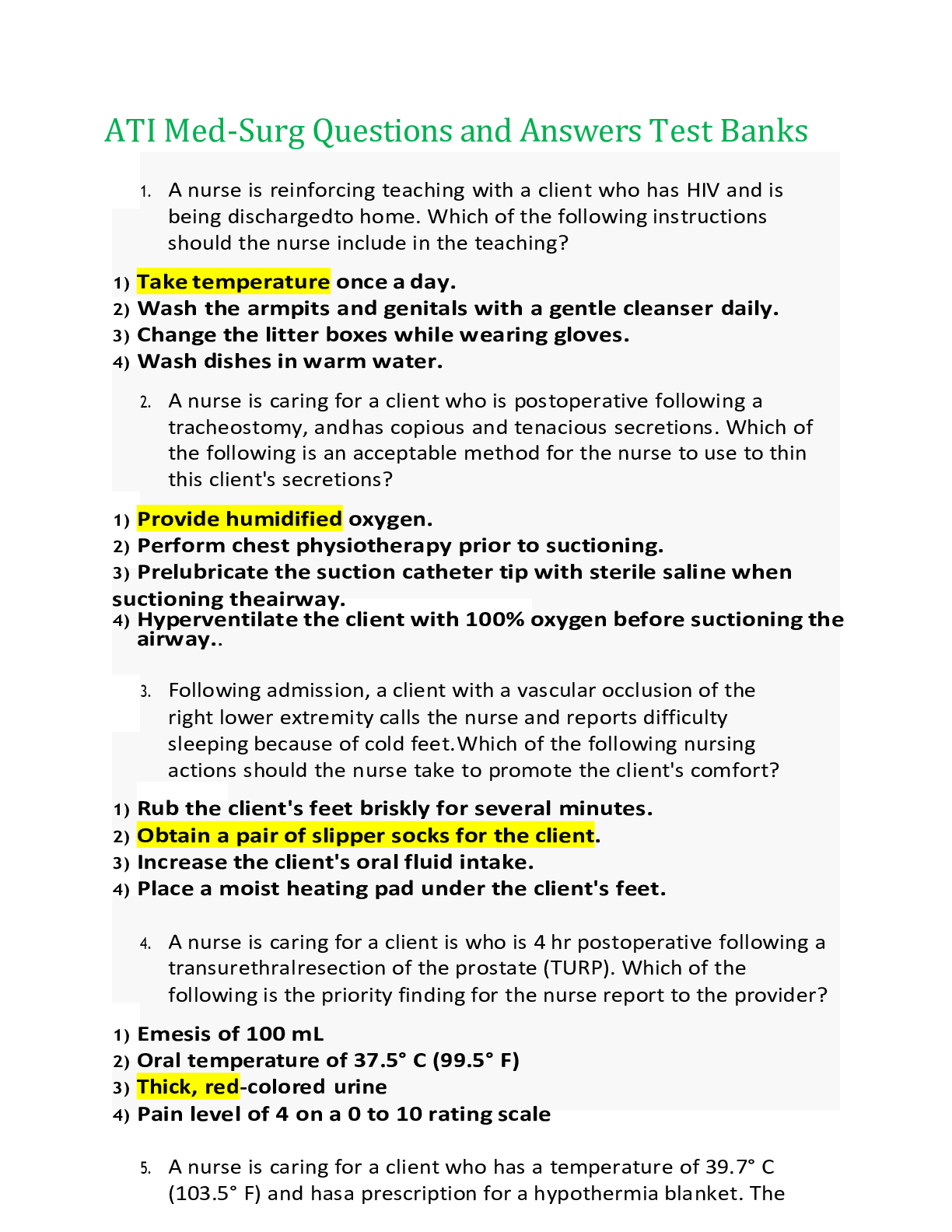
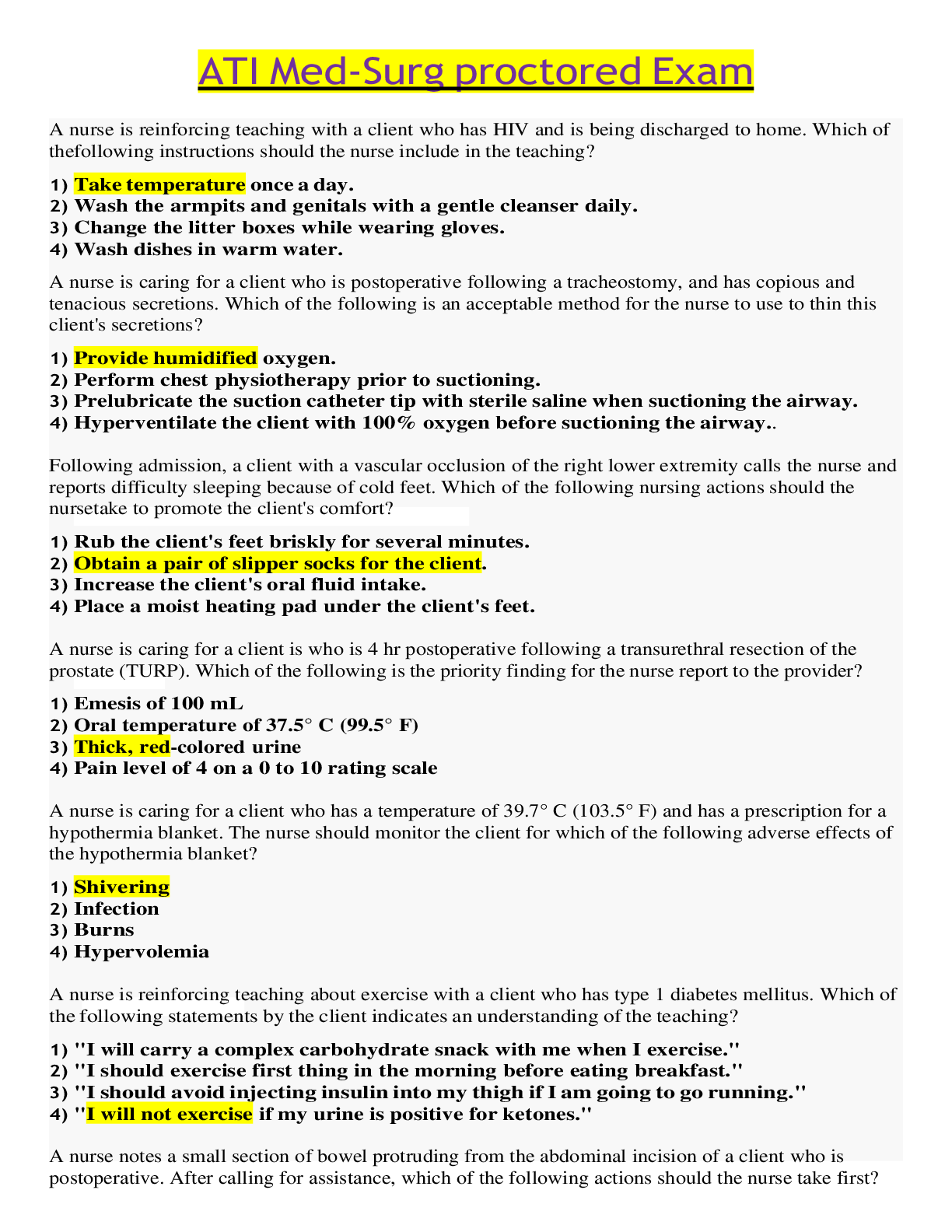
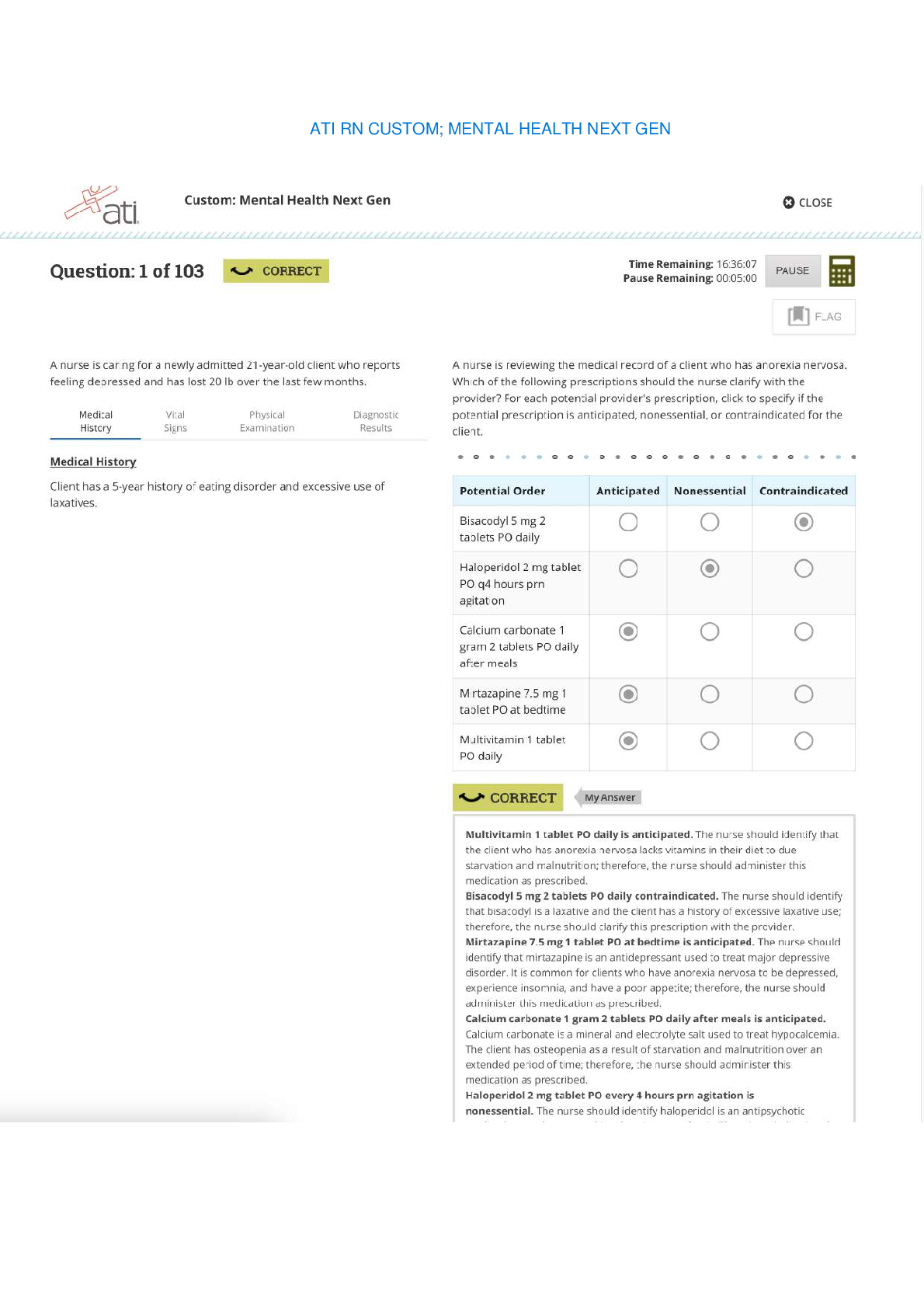
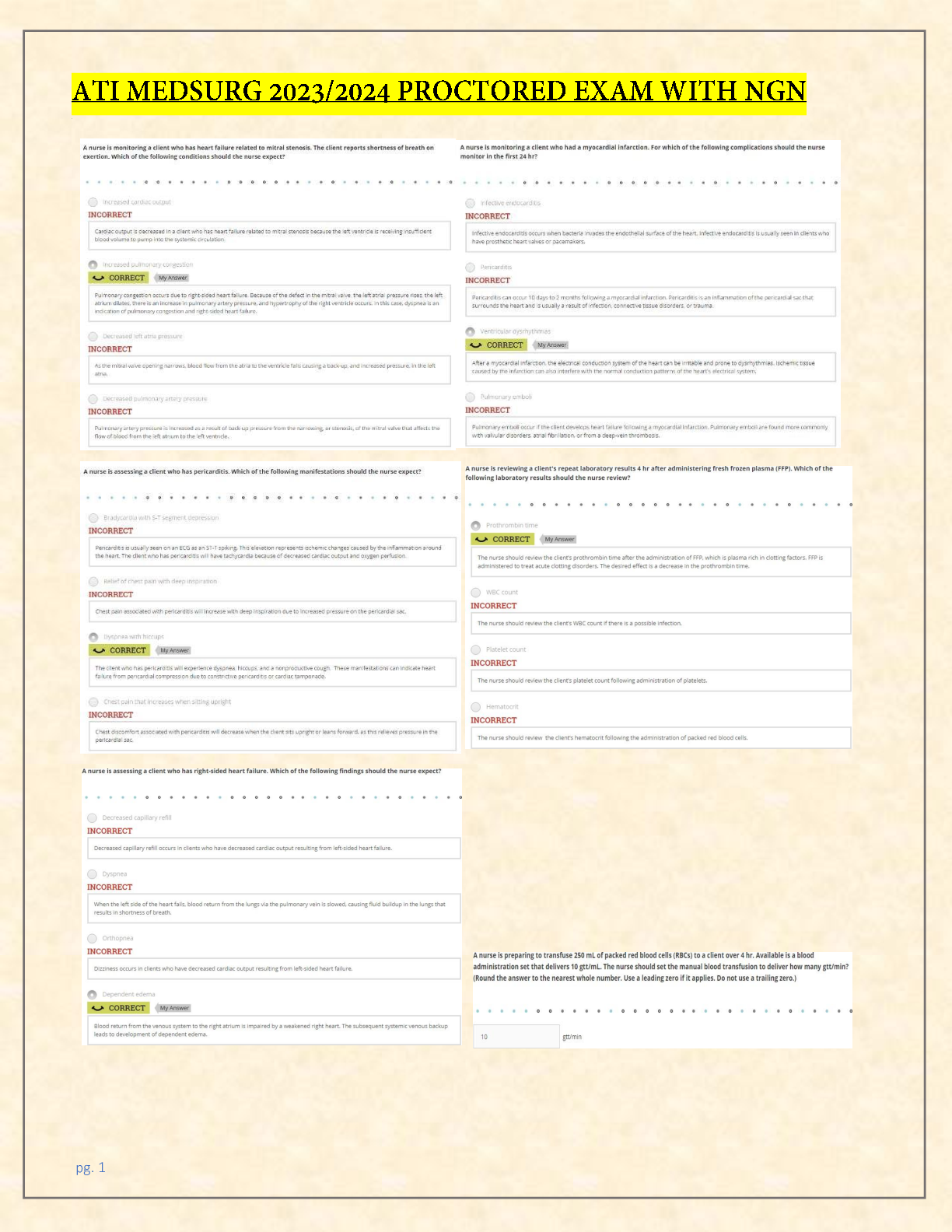
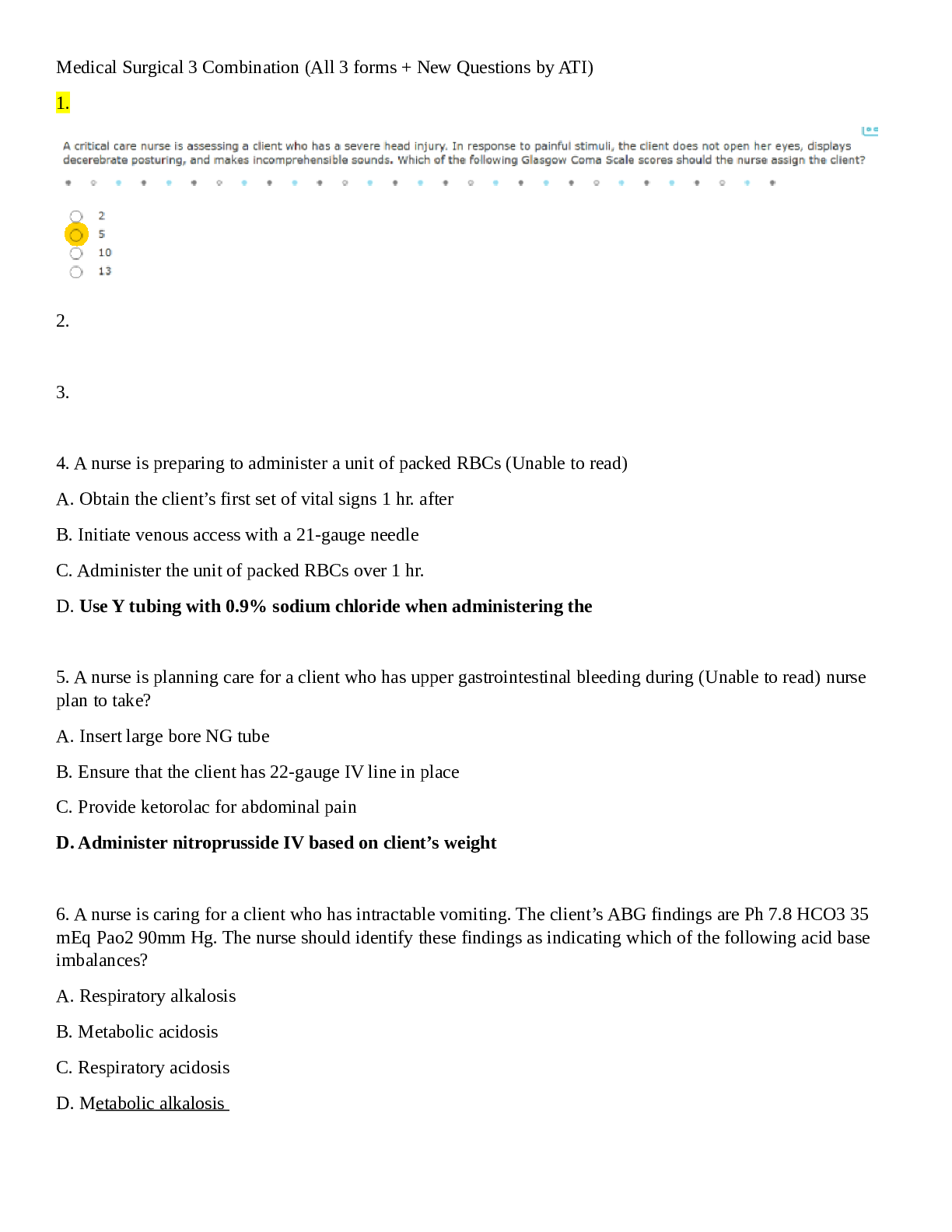
 – Chamberlain College of Nursing.png)
